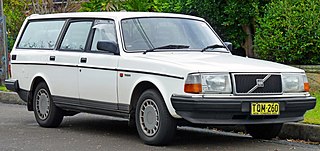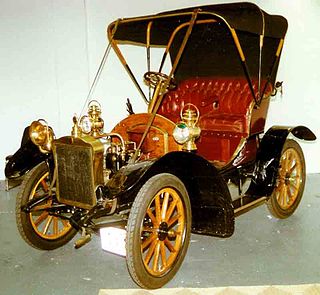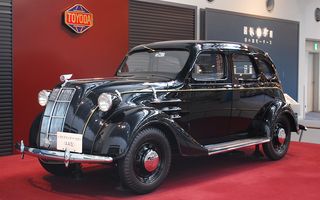
The Volvo Amazon was a mid-sized car manufactured and marketed by Volvo Cars from 1956 to 1970 and introduced in the United States as the 122S at the 1959 New York International Auto Show.

The Duett is an automobile from Volvo that was in production from 1953 until 1969.

Volvo Cars is a Swedish multinational manufacturer of luxury vehicles headquartered in Torslanda, Gothenburg. The company manufactures SUVs, station wagons, and sedans. The company's main marketing arguments are safety and its Swedish heritage and design.

The Volvo S60 series is a compact executive car manufactured and marketed by Volvo since 2000.

The Volvo 164 is a 4-door, 6-cylinder luxury sedan unveiled by Volvo at the Paris Motor Show early in October 1968 and first sold as a 1969 model. 46,008 164s were built before the car was succeeded by the 264 in 1975. The 164 was Volvo's first venture into the luxury segment since the end of PV 60 production in 1950, and was the first six-cylinder Volvo since the PV800 last produced in 1958.

The Volvo C30 is a three-door, front-engine, front-wheel-drive premium compact hatchback, manufactured and marketed by Volvo Cars from 2006 to 2013, in a single generation. Powered by inline-four and straight-five engines, the C30 is variant of the Volvo S40/V50/C70 range, sharing the same Ford C1/Volvo P1 platform. Volvo marketed the C30 as a premium hatchback / sports coupe.

The Volvo 200 Series is a range of mid-size cars produced by Swedish company Volvo Cars from 1974 until 1993, with more than 2.8 million total units sold worldwide. Like the Volvo 140 Series, from which it was developed, it was designed by Jan Wilsgaard.
The Deutsche Tourenwagen Masters is a grand touring car series sanctioned by ITR e.V. who have been affiliated to the DMSB-FIA since 1984. The series is based in Germany, with rounds elsewhere in Europe. The series currently races a modified version of Group GT3 grand touring cars, replacing the silhouette later Class 1 touring cars of earlier years.

The Volvo 440 and 460 are versions of a small family car produced by the Swedish manufacturer Volvo between June 1988 and September 1996. The 440 was a five-door hatchback and the 460 a four-door saloon which followed in 1989. They were built at the NedCar factory in Born, the Netherlands and were only offered with front-wheel drive.

The Volvo 300 Series is a rear-wheel-drive small family car sold from 1976 to 1991, both as a hatchback and as a conventional notchback saloon.

The Volvo PV800 Series is a taxicab manufactured by Volvo from 1938 until 1958. The Sow series dominated the Swedish taxicab market during the 1940s and 1950s.

The Volvo 700 series is a range of executive cars produced by the Swedish manufacturer Volvo Cars from 1982 to 1992. The 700 series was introduced in 1982 with the luxurious 760, followed two years later by the lower priced 740 which capitalized on the prestige attained by the very similar 760. The 700 series was then gradually replaced, beginning in 1990, by the 900 series. The 700, designed by Jan Wilsgaard, was originally to have been a replacement for the 200 series, but production of that model continued until the early nineties. The expensive 780, a Bertone-designed coupé version, entered production in 1986 and departed without a direct successor only four years later.

The Volvo ÖV 4 was the first car built by Volvo. The designation ÖV 4 stands for "Öppen Vagn 4 cylindrar" in Swedish, which means Open Carriage, 4 cylinders. The model ÖV 4 has later often been referred to as "Jakob" but that was just a name for one of the 10 pre-series ÖV 4 that was ready on 25 July 1926, Jakob's name day. All 10 prototypes were assembled in Stockholm at the company AB Galco, Hälsingegatan 41 where Gustaf Larson worked at that time. Only one of the 10 pre-series cars manufactured during 1926 was saved for posterity and is housed at the Volvo Museum in Gothenburg, Sweden.

GEA was a Swedish automobile manufacturer founded by Gustaf Ericsson in 1904 in Stockholm. Originally the company was located in Arbetargatan, but later it moved to Liljeholmen. Together with his study friends from Chalmers University of Technology K G Karlsson and Erik L Magnus they had the expertise needed for the project. The company started making engines, but at first not for cars, but kerosene engines for pumps and agricultural machines. Later they also made boat engines under the name "Gurik". After a few years Gustaf Ericsson thought it was time to build a car. It was to be powered by a six-cylinder engine, a first for Europe. One of the biggest problems was with the magneto. They asked Bosch for help, but they said they couldn't solve the problem. In the end K G Karlsson solved it by using two magnetos. The engine was basically two Fafnir engines in a row, driving the rear wheels via a chain. The chassis was also made in Germany. In 1905 the car was finished. Because of its size it was nicknamed "Ormen Långe". According to news reports it had a top speed of 60 km/h. However the market was not ready for such a car and it didn't enter production. However GEA imported, assembled and adopted cars for the Swedish market. The company folded in 1909.

The Fiat 518, also called Fiat Ardita, was a model of car produced by Italian car manufacturer Fiat between 1933 and 1938. The name "Ardita" was also used on the six-cylinder engined and more expensive Fiat Ardita 2500 or 527.

The Volvo PV51 is a car introduced by Volvo in December 1936. It was replaced by the mildly restyled PV53 in 1938. This car remained in production until the end of the Second World War.

The A1 was the first prototype passenger car built by the company that became Toyota. It was redesigned and put into production as Toyota's first production cars, the AA sedan and the AB cabriolet. These were succeeded by the similar AE, AC and BA sedans.

The Volvo 850 is a compact executive car that was produced by the Swedish manufacturer Volvo Cars from 1991 until 1996. Designed by Jan Wilsgaard, the car was introduced in a saloon body style; an estate style was introduced in 1993.

The Volvo PV650 Series is an automobile manufactured by Volvo between 1929 and 1937. The model name stand for PersonVagn, 6 cylinders, 5 seats; the third digit indicates the version.

The Volvo Concept You is a concept car unveiled by Volvo at the 2011 Shanghai Auto Show.





















